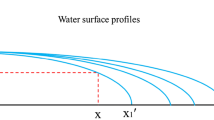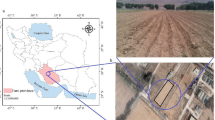Abstract
Manning’s roughness coefficient is one of the most important parameters in the design and evaluation of surface irrigation. In this study, Manning’s roughness coefficient was evaluated under two different inflow discharges (i.e., 0.29 and 0.44 L s− 1) on vegetated furrow irrigation during maize growing season. In addition, the accuracy of multilevel optimization and SIPAR-ID methods was evaluated for the estimation of Manning’s roughness coefficient and infiltration equation parameters in vegetated furrows. Spacing, length, and longitudinal slope of experimental furrows were 0.75 m, 110 m, and 1.2%, respectively. Values of the Manning’s roughness coefficient in the vegetated furrows increased as compared to its recommended values in bare furrows. On the contrary, inflow discharge had a weak inverse impact on Manning’s roughness coefficient. Roughness coefficient was the highest at downstream section (end) of the experimental furrow and its value at the middle section was higher than that of upstream section. The results also indicated that the multilevel optimization method had a good performance with average relative error (RE) about 5% for both discharges and SIPAR-ID method had an approximately proper estimation with relative error ranging from 4.6 to 15% in estimating Manning’s roughness coefficient for all irrigation events. To estimate the infiltrated volume of water into soil, the multilevel optimization method had a very good performance (RE = − 1.65 to 2.81%).
Similar content being viewed by others
Notes
Agricultural Research Service.
United States Department of Agriculture.
References
Abbasi F (2013) Principles of flow in surface irrigation. Iranian National Committee on. Irrigation and Drainage (IRNCID), Tehran (in Persian)
Bautista E, Clemmens AJ, Strelkoff TS, Schlegel J (2009) Modern analysis of surface irrigation systems with WinSRFR. Agric Water Manag 96:1146–1154
Booher LJ (1976) Surface irrigation. Food and Agriculture Organization of the United Nations, Rome
Chow VT (1959) Open channel hydraulics. McGraw-Hill, New York
Ebrahimi NG, Kashefipour SM, Fathi-Moghaddam M, Ebrahimi K, Saneie M (2008) Experimental analysis on the effect of bed vegetation shrub on Manning’s coefficient. Iran Watershed Manag Sci Eng 2:37–42 (in Persian)
Elliott RL, Walker WR (1982) Field evaluation of furrow infiltration and advance functions. Trans ASAE 25:396–400
Esfandiari M, Maheshwari BL (2001) Field evaluation of surface irrigation models. J Agric Eng Res 459–479
Etedali HR, Ebrahimian H, Abbasi F, Liaghat A (2011) Evaluating models for the estimation of furrow irrigation infiltration and roughness. Span J Agric Res 9:641–649
Etedali H, Liaghat A, Abbasi F (2012) Evaluation of the EVALUE model for estimating manning’s roughness in furrow irrigation. Irrig Drain 61:410–415
Gillies MH, Smith RJ (2005) Infiltration parameters from surface irrigation advance and run-off data. Irrig Sci 24(1):25–35
Gillies MH, Smith RJ (2015) SISCO: surface irrigation ssimulation, calibration and optimisation. Irrig Sci 33(5):339–355
Haghayeghi SA, Ansari H (2015) Conservation agriculture and its impact on hydraulics of surface irrigation methods. J Water Sustain Dev 1:81–88 (in Persian)
Kamali P, Ebrahimian H, Verdinejad VR (2015) Evaluation and comparison of multilevel optimization method and IPARM model to estimate infiltration parameters in furrow. Water Irrig Manag 5:43–54 (in Persian)
Li Z, Zhang J (2001) Calculation of field Manning roughness coefficient. Agric Water Manag 49:153–161
Madsen H (2003) Parameter estimation in distributed hydrological catchment modelling using automatic calibration with multiple objectives. Adv Water Resour 26:205–216
Mailapalli DR, Raghuwanshi NS, Singh R, Schmitz GH, Lennartz F (2008) Spatial and temporal variation of manning’s roughness coefficient in furrow irrigation. J Irrig Drain Eng 134:185–192
Mayer DG, Kinghorn BP, Archer AA (2005) Differential evolution an easy and efficient evolutionary algorithm for model optimization. Agric Syst 83:315–328
McClymont DJ, Smith RJ (1996) Infiltration parameters from optimisation on furrow irrigation advance data. Irrig Sci 17:15–22
Minitab Inc (1995) The student edition of MINITAB for Windows. Addison-Wesley Publishing Co., State College
Moravejalahkami B, Mostafazadeh-Fard B, Heidarpour M, Abbasi F (2009) Furrow infiltration and roughness prediction for different furrow inflow hydrographs using a zero-inertia model with a multilevel calibration approach. Biosyst Eng 103:371–381
Morris MR, Hussain A, Gillies MH, O’Halloran NJ (2015) Inflow rate and border irrigation performance. Agric Water Manag 155:76–86
Nie WB, Fei LJ, Ma XY (2014) Applied closed-end furrow irrigation optimized design based on field and simulated advance data. J Agric Sci Technol 16:395–408
Rodriguez JA, Martos JC (2010) SIPAR-ID: freeware for surface irrigation parameter identification. J Environ Model Softw 25(11):1478–1488
Sedaghatdoost A, Ebrahimian H (2015) Calibration of infiltration, roughness and longitudinal dispersivity coefficients in furrow fertigation using inverse modeling with a genetic algorithm. J Biosyst Eng 136:129–139
Sepaskhah AR, Bonder H (2002) Estimation of manning roughness coefficient for bare and vegetated furrow irrigation. J Biosyst Eng 82:351–357
Shabani A, Sepaskhah AR, Kamgar-Haghighi A (2012) Responses of agronomic components of rapeseed (Brassica napus L.) as influenced by deficit irrigation, water salinity and planting method. Int J Plant Prod 7:313–340
Storn R, Price K (1997) Differential evolution: a simple and efficient heuristic for global optimization over continuous spaces. J Glob Optim 11:341–359
Strelkoff T, Katapodes ND (1977) Border irrigation hydraulics with zero-inertia. J Irrig Drain Eng 103:325–342
Strelkoff TS, Clemmens AJ, El-Ansary M, Awad M (1999) Surface-irrigation evaluation models: application to level basins in Egypt. Trans Am Soc Agric Eng 42:1027–1036
Tabatabaei SM, Asadi R (2015) Estimation of infiltration parameters and manning roughness with SIPAR-ID software. Int J Life Sci 9:70–74
Trout TJ (1992) Furrow flow velocity effects on hydraulic roughness. Irrig Drain Eng 118:981–987
United States Department of Agriculture (USDA) (1974) Border irrigation. National Engineering Handbook. Soil Conservation Service, Washington DC, p 55
Walker WR (2005) Multilevel calibration of furrow infiltration and roughness. Irrig Drain Eng 131:129–136
Walker WR, Skogerboe G (1987) Surface irrigation: theory and practice. Prentice-Hall, Englewood Cliffs
Author information
Authors and Affiliations
Corresponding author
Additional information
Communicated by M. Horace Gillies.
Rights and permissions
About this article
Cite this article
Kamali, P., Ebrahimian, H. & Parsinejad, M. Estimation of Manning roughness coefficient for vegetated furrows. Irrig Sci 36, 339–348 (2018). https://doi.org/10.1007/s00271-018-0593-9
Received:
Accepted:
Published:
Issue Date:
DOI: https://doi.org/10.1007/s00271-018-0593-9




